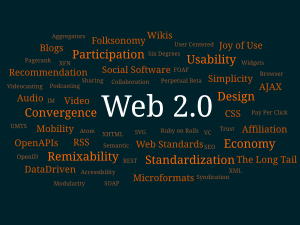When Web 1.0 first came to prominence, most companies were challenged by how to adapt their traditional business models to take advantage of web technology. While the idea of promoting one’s business through flashy websites was almost immediately understood, the concept of buying on-line was more threatening. There was substantial concern among businesses about the impact on their retail outlets and channel partners. IBM, although a leader in e-business, struggled with this decision and initially decided not to sell their computers online over concerns about disintermediating existing suppliers. When it became apparent that Dell was using direct buying to its advantage and was rapidly gaining share in the PC market, IBM had to change its strategy. Such is the nature of disruptive innovation.

A similar paradigm shift is happening now. While Web 2.0 technology has led to the socially aware consumer, organizations are still adapting their culture and processes to enable a broader based shift to social. However, whether it is fear of change or legitimate concerns about shifting the status quo, most of the innovation in social is taking place in marketing and communications, rather than on a broader organizational basis. This puts many marketers in the unique position of being social evangelists and driving change in the organizations they work for.
Marketers have been embracing social since they first realized the incredible reach social technologies provide at a fraction of the cost of traditional advertising and communications. More recently, user generated content and mobile technologies have been utilized by marketers to make the buying process more experiential and to facilitate loyalty. Marketers have bought into the premise of the engaged consumer and now strive for customer intimacy and feedback as well as clarity of communications and branding. But despite this shift, the siloed nature of organizations still persists and the empowerment of employees is often an afterthought. It is my premise that the full value of Web 2.0 will never be realized without a more substantial change in how organizations are governed and that marketers need to play a leadership role in this change.
In his books on change and organizational transformation, Wikinomics and MacroWikinomics, Don Tapscott talks about the shift to mass collaboration and cites examples of how both internal and external crowdsourcing has enabled innovation. He is very clear, however, that success is usually achieved only by organizations who utilize these strategies is conjunction with a change in policies and management strategies. He cites the example of the employees at Best Buy who would not have been instrumental in co-creating the concept of the Geek Squad, if they had not been engaged in the first place.
So what should marketers do to drive broader based social business change in their organizations?
- Be inclusive. Consider how the programs you are running impact other functions and read them in.
- Look beyond initial implementation. What business processes may be impacted by the programs or innovations you are implementing? Plan for the long term.
- Go beyond your own set of metrics. Explore data from other parts of the organization that may demonstrate the success of your programs.
- Gather internal feedback. Don’t just consider customer reactions. Understand employee reactions before and after you implement. Employees are often closest to both the products and customers you serve and might have an idea you have not of thought of.
- Use the outside inside. Think about how external programs relate to internal programs or might translate to something that could be implemented internally. Work cross functionally to explore this premise and make it happen.
Remember, true change occurs when one has the ability to see beyond existing structure and envision a “to be” state rather than simply accept the current premise. Shifting to social is not simply about using Facebook and Twitter and having more engaged customers–it is about enabling engagement and collaboration throughout the entire organization and its ecosystem. Marketers should not be afraid to be social evangelists and lead the shift in paradigms. In the end, it is this type of change that will bring forth the full promise of social business and make them more effective.







